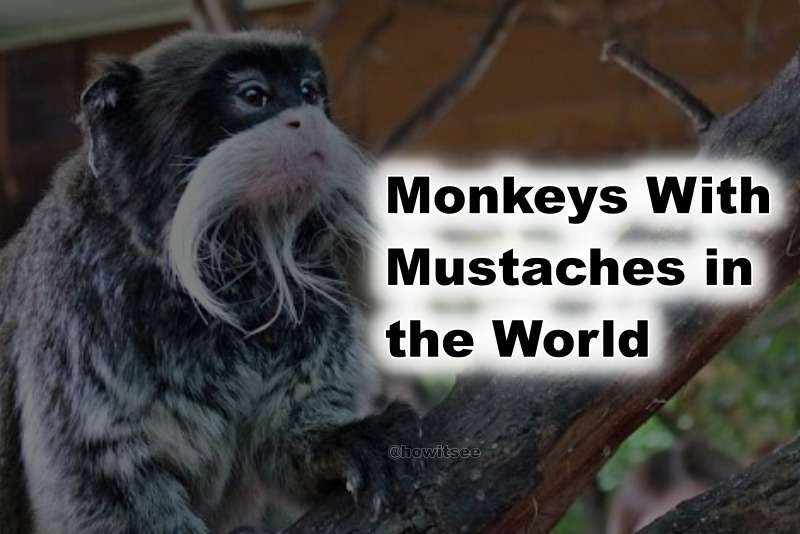There are many intriguing organisms in the natural world. Primate species are one of the many animal groups that never cease to amaze humans. There are more than 300 species of primates, and they’re all renowned for their high levels of cognition, learned behavior, and social interaction.
Yet among all the many kinds of primates, there’s one tribe that stands out for its remarkable facial hair. Mustached monkeys are an unusual and endearing sight, and we’ll learn more about them here.
Exploring their anatomy, habitats, behaviors, and conservation status, we will identify the top 10 mustachioed monkey species. The wonderful world of mustached monkeys is about to astound and enchant you.
How can we define monkeys with mustaches?
They are called “monkeys with mustaches” because their unique facial hair resembles a human mustache. This facial hair commonly develops above the top lip; it can grow rather long and magnificent whiskers in certain species.
The mustache has several functions, from expressing oneself socially to attracting mates to shielding one’s face from the weather.
Mustached monkeys may be seen in various sizes, hues, and overall appearances. The emperor tamarin, the golden lion tamarin, the Francois’ langur, and the Goeldi’s monkey are well-known monkey species with mustaches.
10 Monkeys With Mustaches in the World
1) Emperor tamarin
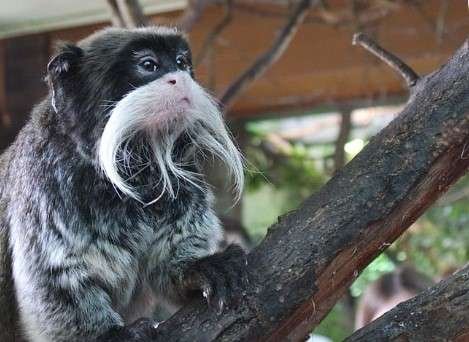
| Scientific Name | Saguinus imperator |
| Size | 9-10 Inches |
| Fur Color | They have a distinctive appearance with their long white mustache, grayish-brown back, and reddish-orange feet and hands. |
| Life span | 15-20 Years |
| Location | Amazon Basin |
| Diet | Fruits, insects, and small animals like lizards and frogs. |
The emperor tamarin has primarily grey fur, with some yellowish markings on its chest. The tail, hands, and feet are brown, whereas the body is black.
Most notably, it has a long, white beard that reaches past the shoulders on both sides. The animal’s total length is 23–26 centimeters (9–10 inches), including the tail, which is another 35–41.5 centimeters (13.8–16.3 inches). About 500 grams is how much it weighs (18 oz).
Every one of its digits, except its big toe, which has a nail, is equipped with a sharp claw. It sports a large, bushy mustache and a few wispy white hairs that almost go unnoticed on its chin. Nonetheless, the sanguineous imperator can be identified by its distinctive black chin.
It has a patchwork of red, orange, and white hairs on its chest and belly. The fur is a deep chocolate brown on its back. It has an orange tint on the inside of its limbs and legs.
2) Blue Nile Patas Monkey
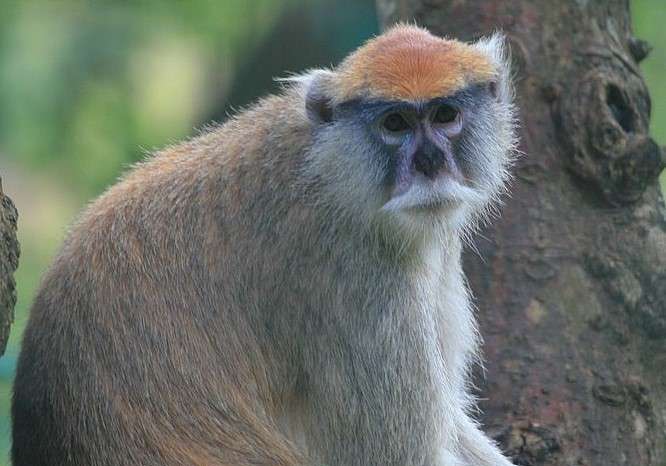
| Scientific Name | Erythrocebus poliophaeus |
| Size | 17-23 cm |
| Fur Color | They have a uniform reddish fur color on their body |
| Life span | Up to 15 Years |
| Location | Africa |
| Diet | Fruit, insects, and small vertebrates. They also consume plant exudates, such as sap and gum. |
A species of Old World monkey known as the Blue Nile patas monkey (Erythrocebus poliophaeus) or Heuglin’s patas monkey is found in Africa in the Blue Nile river basin in Ethiopia, Sudan, and maybe South Sudan.
It was initially described in 1862, but it wasn’t until 1927 that it was compared to the common patas monkey (E. patas).
The upper lip hair on this species is covered with white hairs that resemble handlebar mustaches. This sets it apart from the other members of the genus Erythrocebus, as does the absence of the band between the ear and eye.
3) Black-tufted marmoset
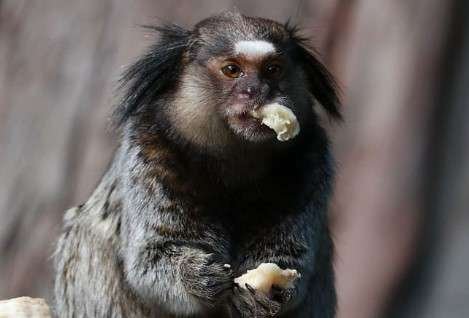
| Scientific Name | Callithrix penicillata |
| Size | 18-28 cm |
| Fur Color | They have black fur on their back and limbs and white skin on their underbelly, face, and ears. They also have distinctive tufts of black hair on their ears. |
| Life span | 8-16 Years |
| Location | Brazil |
| Diet | Insects, fruit, tree gum, and other small animals |
The black-tufted marmoset can be identified by the tufts of black hair that grow from behind its ears. It has a few white hairs on its face, although they are usually scanty.
Its back and underbelly are often black, its head is brown or black, and its limbs and upper body are gray. The black and white rings on its tail are not prehensile; instead, it serves as a stabilizer.
They have prominent brown or white mustaches. Without an opposable thumb, its nails seem more like claws. The adult black-tufted marmoset can measure between 7.48 and 8.7 inches (19.0 and 22.1 centimeters) in length and weigh up to 12.35 ounces (340 milligrams) (350 g).
4) Pygmy marmoset
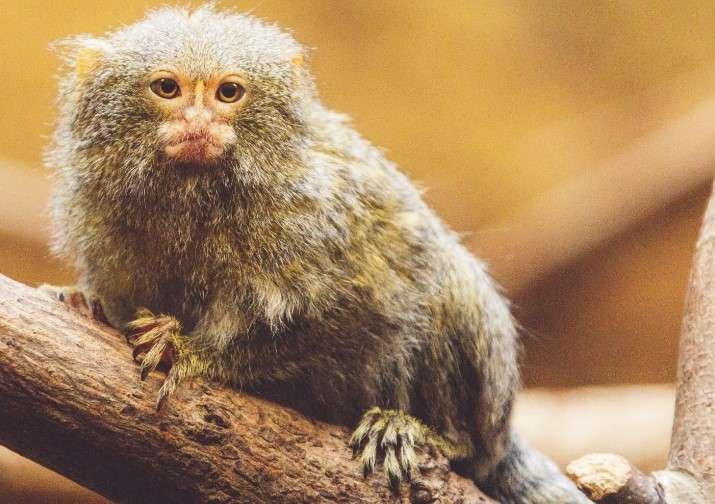
| Scientific Name | Cebuella pygmaea |
| Size | 12-15 cm |
| Fur Color | Their fur is usually a mix of brown, grey, and black, with a distinctive white “ear tuft” on either side of their head. |
| Life span | Up to 12 Years |
| Location | Rainforest of South America, including Brazil |
| Diet | Insects, spiders, fruit, and tree sap |
The head-body length of a pygmy marmoset is only about 117 mm (4.6 in), and its tail is another 172 mm (6.3 in) long, making it the smallest genuine monkey in the world (6.8 to 9.0 in).
Its back and head have a brownish-gold, grey, and black fur pattern, while its underbelly is vibrant yellow, orange, and tawny. They have small white mustaches.
Black rings may be seen around its tail, with a white vertical line across its eyes and some white speckles on its cheeks.
Its sharp, claw-like nails let it cling to tree branches and trunks, and it can turn its head through a full 180 degrees. The sole sexual dimorphism is that females are a bit heavier than males, with a mean mature body weight of just over 100 g (3.5 oz).
5) Red-tailed Guenon
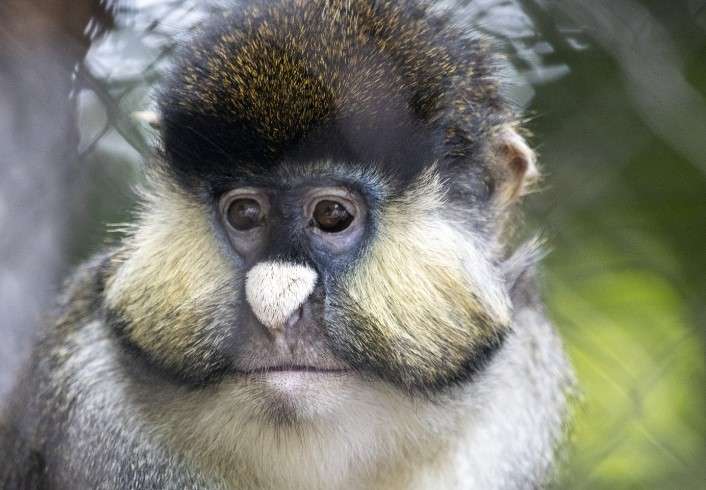
| Scientific Name | Cercopithecus ascanius |
| Size | 30-60 cm |
| Fur Color | They have brown, black, or grey fur on their body |
| Life span | 10-18 Years |
| Location | East Central Africa |
| Diet | Fruits, insects, spiders, small vertebrates, and flowers. |
The red-tailed guenon gets its name from the coloration of its underbelly, which is red, as well as from the tail’s bi-coloration, which is reddish from the base to the tip. They also have mustaches that look beautiful.
Other characteristics of this creature are its white cheeks and nose, which contrast with its black or dark grey body fur.
Moreover, red-tailed guenons have enormous, elastic cheeks that they employ to gather food and store it in their mouths for protection.
6) De Brazza’s Monkey
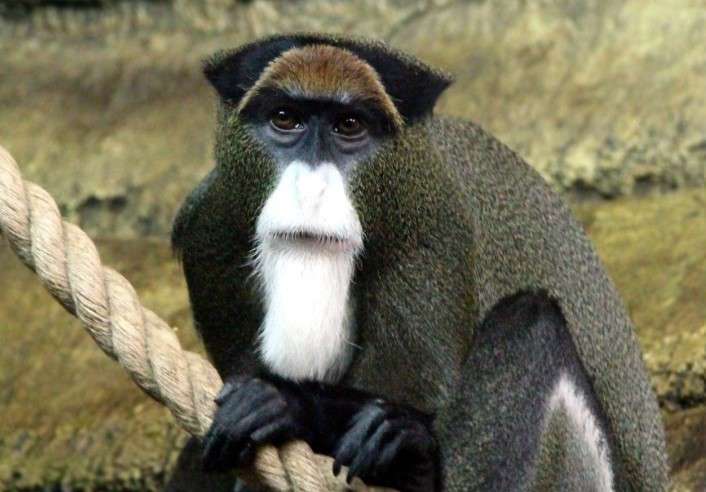
| Scientific Name | Cercopithecus neglectus |
| Size | 30-40 cm |
| Fur Color | Grey agouti fur with reddish-brown back |
| Life span | 15-20 Years |
| Location | Central Africa |
| Diet | Fruits, nuts, insects, small vertebrates, and bird eggs. |
De Brazza’s monkey, a magnificent thickset guenon with a short tail, a hairy face with a reddish-brown patch around its eyes, a white band across its brow, and an eye-catching white beard and white mustache.
They hold food in their cheek pouches when foraging. Adults have darker colors on their extremities, but juveniles don’t. Instead, they have white stripes and a red rump.
Babies have a consistent brown agouti with only a little beard. It may be distinguished from other guenons by its white beard and muzzle, an orange crescent on its forehead, and white stripes on its thighs.
7) Red-bellied tamarin
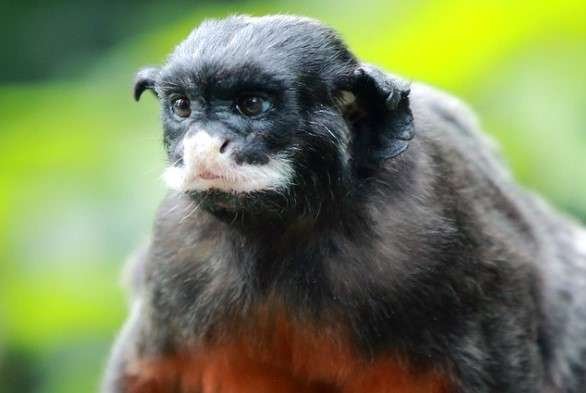
| Scientific Name | Saguinus labiatus |
| Size | 20-30 cm |
| Fur Color | The fur on their back is brownish-black, and their underbelly is red or orange. They also have a white mustache and a reddish-brown forehead. |
| Life span | 10-16 Years |
| Location | Amazon Basin |
| Diet | Fruit, insects, nectar, and small animals. |
Saguinus labiatus, or the white-lipped tamarin, is a species found in the Amazon rainforests of Brazil and Bolivia.
The New World monkey’s most distinguishing feature is its bright red belly. Its small white mustache stands in stark contrast to its otherwise all-black appearance.
Animals of the same species tend to congregate together in communities. Typically, a mother will have one or two babies at a time.
Babies generally are carried by the father, but brothers and sisters will also take turns so they may learn how to be effective caregivers.
8) Moustached Guenon
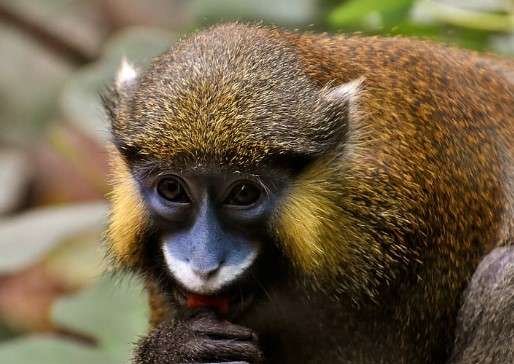
| Scientific Name | Cercopithecus cephus |
| Size | 45-60 cm |
| Fur Color | Black and Reddish gold |
| Life span | Around 20 Years |
| Location | Angola, Congo, Gabon, Guinea |
| Diet | Fruits, insects, leaves, and other small animals |
It has a vivid blue-to-purple face with a thin, crescent-shaped stripe of bluish-white color beneath the bare snout. The top lip’s edge is covered in black hair, and the sideburns on either side of the face are bushy and brilliant yellow.
The C. Cephus has prominent, expanded cheekbones, the most typical mustache is a crescent-shaped, white strip of fur under the nose, and the surrounding fur is black, creating a striking contrast in color; as a result, the face patterns can be thought of as visual signals.
Black hair covers the majority of the head, while the ears are brown. The ventral section has ash-gray hair, and the dorsal and lateral portions of this hair are black-brown. The tail is non-prehensile, longer than the rest of the body, and covered in copper-red fur.
9) Balinese Long Tailed Macaques
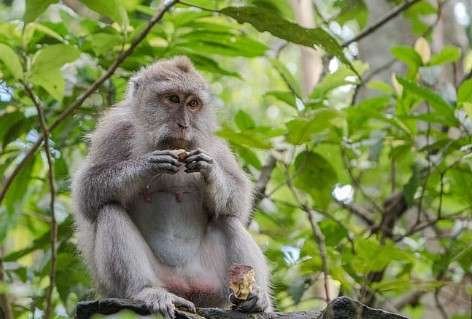
| Scientific Name | Macaca fascicularis |
| Size | 38-55 cm |
| Fur Color | Black or grey-brown to reddish brown |
| Life span | 15-30 Years |
| Location | Southeast Asia |
| Diet | Fruits, insects, small vertebrates, and tree exudates. |
“Ecologically varied” describes long-tailed macaques. They have been discovered in a variety of environments, including primary forests, disturbed and secondary forests, riverine and coastal mangroves, and nipa palm forests.
The most prosperous living conditions for long-tailed macaques are disturbed habitats and the edges of forests. The cheek whiskers are brownish grey, and the face is.
For binocular vision, the eyes are pointed forward. The nostrils are small and closely spaced, and the nose is flat (catarrhine condition). The canines, molars, and shovel-shaped incisors of long-tailed macaques are all prominent.
10) The Mandrill
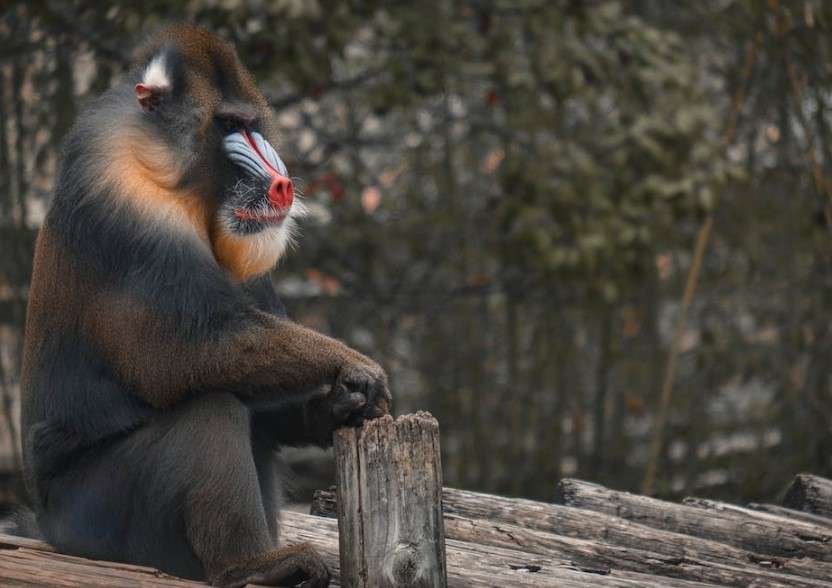
| Scientific Name | Mandrillus sphinx |
| Size | 40-65 cm |
| Fur Color | They have an olive-brown fur color |
| Life span | 20Years |
| Location | Rainforests of Equatorial Africa |
| Diet | Fruits, insects, small vertebrates, nectar, and sometimes tree sap and gums. |
The mandrills stand about 80 cm tall. The species is distinguished by a huge head, a small body with long, strong limbs, and an upright, short tail.
The clavicles’ extensive range of rotation enables quadrupedal walking, tree climbing, and arm movement. These monkeys can hold tree branches thanks to their opposable thumbs.
Mammary glands are found in pairs in the chest of both sexes. They have beautiful white mustaches.
The underparts are lighter, and the coat is olive green. Its rump is a vivid blue-to-purple color. The mandrill’s face features a red stripe around the nostrils and down the middle of the snout, with blue stripes running down the sides of the nose.
Mandrills have yellow beards and red patches of fur over their eyes. Compared to adult males, these colorations are duller in females and young animals.
Here, in this post, we have discussed the list of the 10 Monkeys With Mustaches in the World. We hope you like this post. We will be
Also Read

A writer who studied agriculture. Nature has always drawn me in, and my main goal in writing about it is to discover some of its secrets. You can usually find me reading Bengali and English masterpieces or filling the room with lovely music if I’m not engrossed in nature or anime material. I adore playing the guitar. I’m also that friend of yours who enjoys playing video games.
